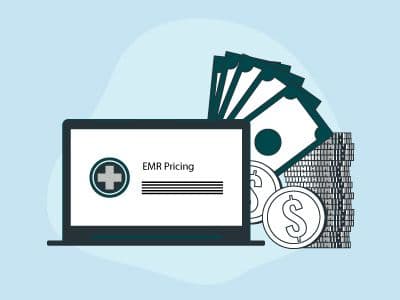How much should an electronic medical records (EMR) system cost? Unfortunately, there is no simple answer. Even free or open-source EMRs can sometimes have hidden fees that throw your original budget into disarray.
Understanding how much a new or replacement system will cost, your company can take days of online research and meetings with vendors. The cost of EMR system depends on various factors. After all, you may find yourself paying more than you expected for features you require but assumed were provided by the vendor at no additional cost.
With this in mind, we've put together this comprehensive guide to help you compare the pricing of top-rated EMR systems, find out how much others are paying, and find the perfect product for your budget.
Factors Affecting EMR Pricing
On the majority of websites, medical software providers frequently do not disclose pricing information. Instead, they encourage interested buyers to contact their sales team for a quote. However, the following are some of the factors that influence the cost of EHR:
- Do you just want an EHR, or do you want to integrate practice management apps like scheduling and billing?
- How many users will need unique logins, and what types will access the system (e.g., doctors, nurse practitioners, physician assistants, therapists, office managers)?
- Will you require additional assistance with training and setup, or does your office have dedicated IT staff to help?
- Are you looking to migrate patient data from your current system, or are you looking to purchase EHR software for the first time?
Depending on how you answer the above questions, a vendor may quote you hundreds of dollars less or thousands more for the same system.
EMR Pricing Models
When comparing EMR price lists, there are two main types of EHR pricing models: perpetual licenses and subscription licenses. Although you may already have a basic understanding of EMR cost comparison, view the full upfront, recurring, and hidden costs of each below.
Perpetual License
With a Perpetual license, you pay a one-time fee to own the EMR software and use it indefinitely.
Upfront Costs
- A one-time license fee (which can range anywhere from $1,200 to $500,000)
- Apparatus (e.g., servers)
Recurring Costs
- Maintenance on a monthly, annual, or ad hoc basis (e.g., updates, patches, and upgrades)
- Premium customer service options (e.g., expanded phone support hours)
Hidden Costs
- Personalization (e.g., note templates with custom fields, reporting, and analytics capabilities)
- Connecting to existing systems (e.g., healthcare customer relationship management or business intelligence tools)
Subscription License
A subscription model allows you to pay a monthly fee for a set amount of time to use EMR software.
Upfront Costs
- Installation/setup costs
Recurring Costs
- A monthly subscription fee per provider or user (which can range from $200 for a basic system to $35,000 or more for systems used by large healthcare organizations).
- Premium customer service options (e.g., expanded phone support hours)
Hidden Costs
- Customization (for example, note templates with custom fields and reporting/analytics tools)
- Connecting to existing systems (e.g., healthcare customer relationship management or business intelligence tools)
- Keeping things in storage (e.g., extra GBs for patient data)
Bottom Line
We hope that the information we have provided will help you avoid price hikes when evaluating EMR systems. However, before you start evaluating vendors, it's critical to factor in these often-overlooked EMR costs. This way, you can include them in your budget from the beginning.
